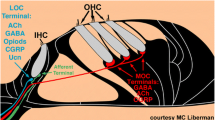Abstract
Congenital hypothyroidism results in deafness that is caused by changes in the auditory receptor, including scanty development of the outer hair cells and a lack of synaptogenesis between these cells and the efferent system, although the afferent population is present. The normal efferent innervation of the cochlea originates in the superior olivary complex, arising from efferent neurons belonging to the lateral or to the medial olivocochlear system. In the rat, the former is constituted by neurons located in the lateral superior olivary nucleus, that project to the inner hair cells, while the later originates in the ventral nuclei of the trapezoid body and project to the outer hair cells. The aim of this work is to study the localization, number and morphology of the olivochochlear neurons in congenital hypothyroid animals by means of the injections of the retrograde tracers, either fast blue or cholera toxin, in the cochlea. The mean total number of labeled olivocochlear neurons after injection of fast blue in hypothyroid animals was 1,016, and in control ones was 1,027. Using cholera toxin, the mean total number of labeled olivocochlear neurons was slightly lower: 863 in hypothyroid animals versus 910 in control ones. Although both tracers showed no significant differences between groups, when the somatic area of the labeled olivocochlear neurons is considered, the size of all of the three different population of cells (lateral olivocochlear neurons, medial olivocochlear neurons and shell neurons) was significantly lower in the hypothyroid rats. This is the first study of the olivocochlear neurons in hypothyroid animals. The conclusion from this work is that in hypothyroid rats the labeled olivocochlear neurons are significantly smaller but that there is not any modification in the localization and number of the labeled olivocochlear neurons, suggesting that thyroid hormones are necessary for the neuronal growth. However, most of the medial olivocochlear neurons do not make contact with their target, so their maintenance suggests that the axons are in contact with other structures of the cochlea.
Similar content being viewed by others
Author information
Authors and Affiliations
Additional information
Accepted: 18 October 1999
Rights and permissions
About this article
Cite this article
Cantos, R., López, D., Sala, M. et al. Study of the olivocochlear neurons using two different tracers, fast blue and cholera toxin, in hypothyroid rats. Anat Embryol 201, 245–257 (2000). https://doi.org/10.1007/s004290050315
Issue Date:
DOI: https://doi.org/10.1007/s004290050315




